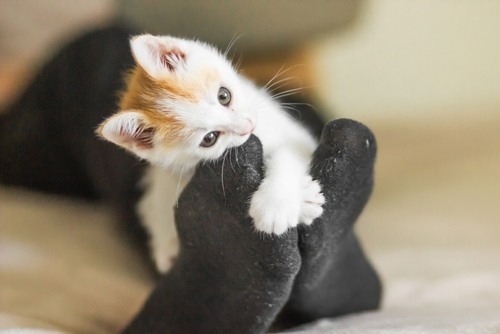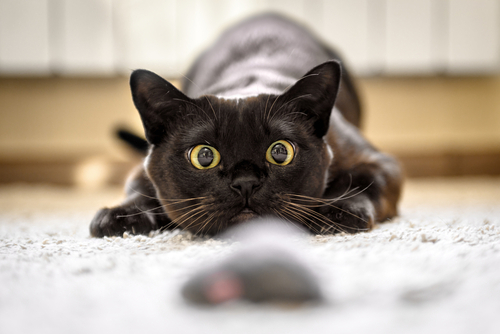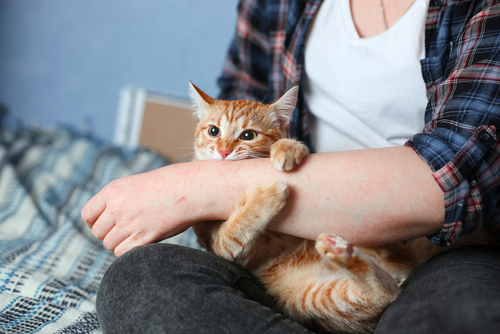When most people adopt a kitten, they don’t usually think of it as having a tiny hunter prowling around the house. Typically the sentiment is much sweeter, more heartfelt, like look at that cute, furry kitten bouncing around on the sofa.
While kittens are undoubtedly adorable and cuddly, and you may have cuter questions such as, “why is my kitten sucking on my blanket?” and other adorable their wild side can come out from time to time. During play, cats often stalk, pounce, kick, and bite their playmate. More often than not, this behavior is innocuous. But if you notice flattened ears or puffed fur, you might have an angry kitty on your hands.
To create a calm and safe environment for all, it’s important to nip your cat’s behavior in the bud before tiny nibbles escalate to painful chomps.
Why Do Cats Scratch and Bite?
Wondering, “why is my kitten attacking me?” Knowing how to get a kitten to stop attacking you comes down to diagnosing why they’re acting that way in the first place.
Each situation is different, and there are various reasons why your cat may exhibit combative behavior. Often, aggression can stem from foreign or unfamiliar stimuli, like loud noises; old age; or lack of stimulation and play during the day.
It’s important to remember that cats are animals. And although some cats have been domesticated and turned into sweater-clad pets, they still have behavioral instincts from thousands of years of evolution in the wild.
That said, here are some of the most common reasons why you’re cat may be attacking you:
Fear
Have you ever heard of the phrase scaredy cat or fraidy cat? Cats can be extremely sensitive, and fear is a typical response, especially when they feel threatened. The threat may not be evident to us. Still, it can be anything from a strange or loud noise or an unfamiliar person to being forced outside of their comfort zone.
Redirected Aggression
This is as common in cats as in humans. Something bothers us, and then we take it out on someone close to us. Cats do this all the time. The initial aggression could be anything from seeing an animal through the window to hearing an unpleasant noise. If your cat can’t respond directly, they will often redirect the aggression toward the owner.
Physical discomfort
A cat may respond aggressively by hissing, swatting, or biting if they experience pain or discomfort, especially if touched where the pain resides. You may also notice your cat throwing up but otherwise seems fine. It’s expected that some cats may continue to act aggressively even after once-painful or irritable parts of their body have healed, presumably to avoid the pain they experienced previously.1
Lack of Play
Suppose a cat didn’t have much interaction or lacked the opportunity to play with humans or other cats in the first few months of its life. In that case, it may be common to respond aggressively. Cats learn that they are biting or scratching too hard when their littermates stop playing or retaliate, so it’s only natural that cats raised alone during their early lives may not learn this important lesson.1
Once you’ve diagnosed your kitty’s behavior, you can begin adjusting their behavior.
Step 1: Ignore or Shift Away From the Behavior When it Begins
Bad habits develop over time. If they aren’t checked at the beginning of the relationship, it only gets more challenging to change this behavior. That’s why it’s essential to establish boundaries of what’s acceptable and unacceptable with your feline friends early on.
One way to do this is by using your voice.
When your cat begins to play too rough or scratches you, it’s essential to let them know this type of behavior is unacceptable. Use your voice and firmly say no after they’ve bitten or scratched you. It’s vital that you remain calm and don’t shout at them.
The goal isn’t to punish them but to teach them how to play nicely.
Once they’ve calmed down, it’s okay to begin playing again. Still, if the aggressive behavior persists, it’s crucial to repeat the process. It may not be easy to ignore your cute kitten. Yet, it’s essential to establish what type of behavior is acceptable.
With consistency, the kitten will learn that nipping and pouncing leads to a loss of attention and that it’s not in their best self-interest to continue with this behavior.2
Step 2: Use Scratching Posts and Toys to Stimulate Behavioral Training
Scratching posts and toys provide cats with a way to exercise and play solo while you’re away or at work. With positive stimulation throughout the day, your cat may be less likely to act out come bedtime.
A scratching post is more than a good grooming practice. Running their claws along the textured surface can release“feel-good” hormones that allow your kitty to release stress or express excitement.
Whether you’re opting for an aesthetically pleasing cactus-shaped post or a more traditional cylindrical scratcher, there are a few factors that you should consider before bringing one home:
- Durability – When cats play and claw, they like a challenge. As such, you’ll want a post that can stand up to your kitten’s sharp claws and gnawing teeth. If the scratch post isn’t strong enough, or it’s not creating adequate resistance for the cat, it may get bored over time. So make sure your scratching post is solid and stable enough for your cat.
- Location – Put the scratching post in a place your cat visits often. This could be next to its bed or lounge area. It won’t help much if you put it in a space the cat rarely goes or doesn’t feel comfortable.
- Height – Cats love to stretch, and when they stretch, they scratch. So your post must be long enough for your cat to rejoice in that early morning scratch at full stretch.
Catnip-filled toys and colorful feathers are another form of mental enrichment that can help facilitate behavioral training. Interactive play provides an outlet for your kitten to practice its natural hunting skills and build its confidence. Plus, fun toys can distract your cat from pouncing on your unsuspecting hand.
That said, cats love toys that resemble prey. We’re talking about scruffy mice, feathered birds, and lanky lizards. Cats are stalkers by nature, despite their domestication. While stationary toys are not a substitute for interactive play, they can provide your kitten with plenty of distraction and engagement when they’re not interacting with you.2
Step 3: Create A Safe and Healthy Environment for Your Kitten
If you want your cat to thrive and behave, creating a safe and healthy environment for your kitten is essential. Recent genetic studies show that domestic cats are only partially domesticated, meaning that many traits of their wild ancestors are still lurking in our feline companions.3
With that said, cat owners must understand this and know how to create an environment that is healthy and suitable for the cat’s needs. The American Association of Feline Practitioners and the International Society of Feline Medicine have put together the five pillars of a healthy feline environment:4
- Pillar 1 – Create a safe and cozy environment for your kitten where it can retreat if it feels threatened, unsure, or frightened, such as a box, carrier, or perch.
- Pillar 2 – Make sure your kitty has everything it needs to feel comfortable (and respected!). You’ll want to regularly fill its water bowl and clean its litter box. You can also provide designated play, scratching, and sleeping spaces where your little fluff ball can feel at home and at ease.
- Pillar 3 – Give your kitty an outlet to let out its hunting behaviors. Failing to provide cats with options for each can result in obesity, boredom, or frustration. These can lead to the cat overgrooming itself, stress-associated diseases, or even redirected aggression.
- Pillar 4 – Cats love predictability. As such, you’ll want to treat your kitten kindly and avoid forced interaction. Give them plenty of space, but pay attention to their social preferences. Sometimes, ignoring your kitten for too long can lead to aggression and other behavioral problems.
- Pillar 5 – Kittens use their sense of smell to navigate the world. As such, it’s important that you remove any harmful products or substances from your home and provide scratching posts where cats can deposit any outdoor scents.
Step 4: Care For Your Kitty With Canna-Pet®
The good news is that teaching a kitten how to play nicely isn’t as hard as one may think. Time, love, and patience can go a long way in supporting your kitten through its most rambunctious moments. And so can Canna-Pet® CBD.
At Canna-Pet®, our pet-friendly CBD is 100% organic and third-party tested. Our full-spectrum hemp extract can help soothe and calm your furry friends situationally or be taken as a daily supplement.
Ease your pet into gentle play with Canna-Pet®.
Sources:
- Cornell Feline Health Center. Feline Behavior Problems: Aggression. https://www.vet.cornell.edu/departments-centers-and-institutes/cornell-feline-health-center/health-information/feline-health-topics/feline-behavior-problems-aggression
- The Humane Society of the United States. Teach Your Kitten How to Play Nice. https://www.humanesociety.org/resources/teach-your-kitten-how-play-nice
- Morris Animal Foundation. How to Make Your Home Cat Friendly. https://www.morrisanimalfoundation.org/article/how-to-create-healthy-indoor-environment-your-cat
- Journal of Feline Medicine and Surgery. AAFP and ISFM Feline Environmental Needs Guidelines. https://journals.sagepub.com/doi/pdf/10.1177/1098612×13477537







